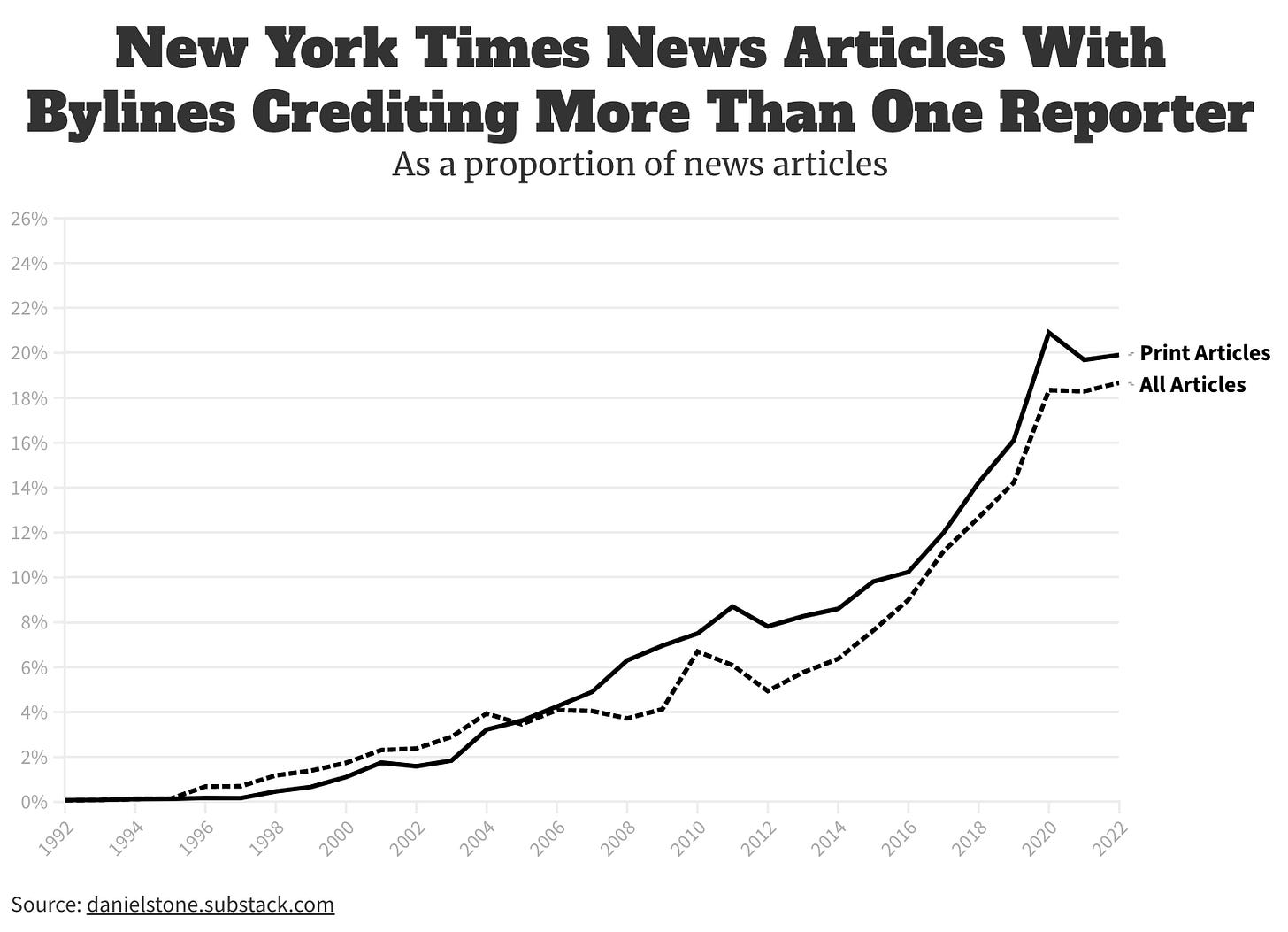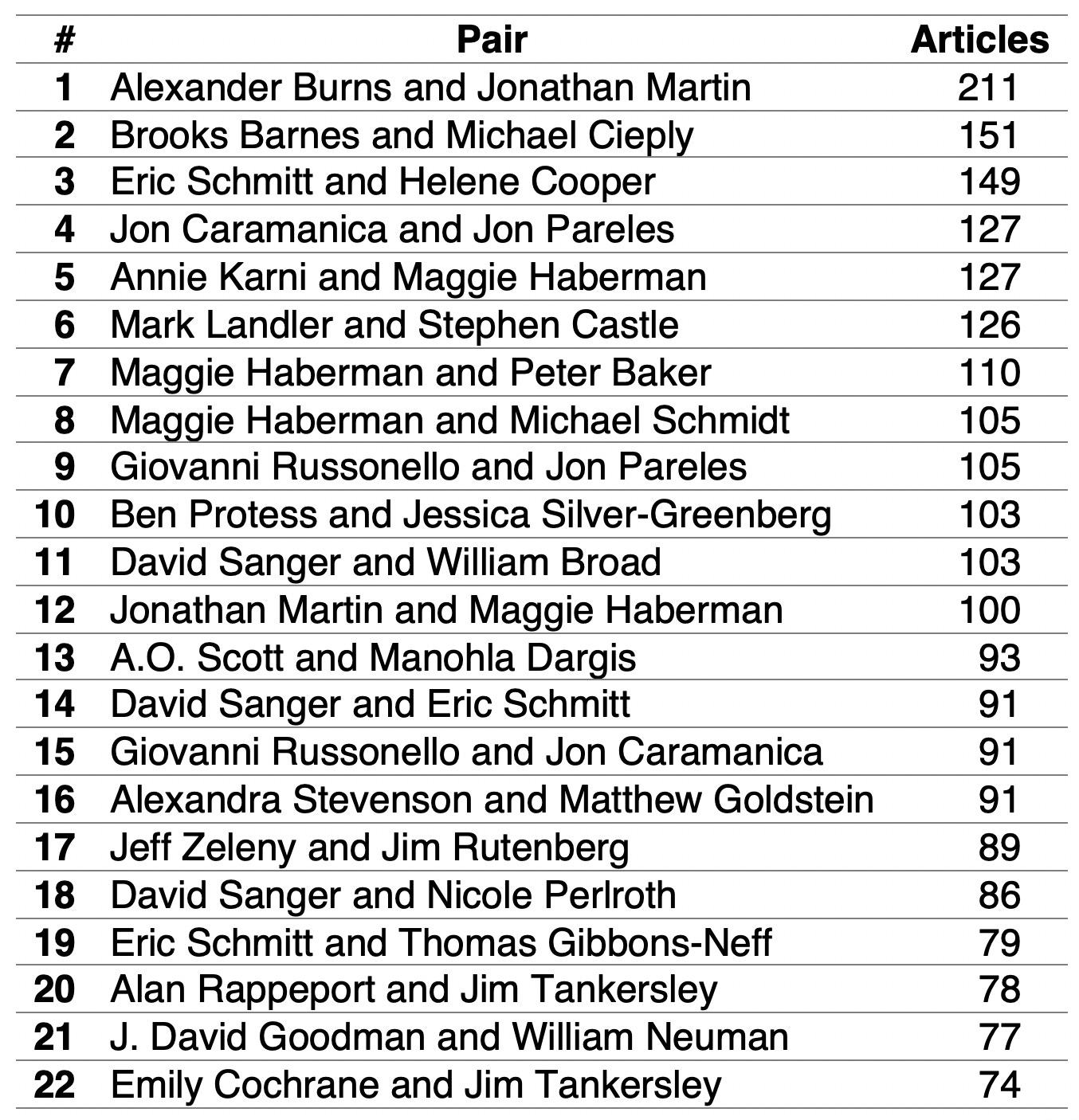A few years ago, I found myself looking at New York Times bylines a lot more. I couldn’t help it really.
I was used to seeing a single line of type under each headline reading “By First Last.” Suddenly, or so it felt, every article was written by a team. The multi-bylines (as I’ll call them) took up more space and their visual novelty, more than anything, made me notice them.
My impression was partially right, but not entirely. Looking at thirty years of the Times index I found that today about 18% of all New York Times news articles (and 20% of those appearing in print) are multi-bylined—hardly “every” article, but still a decent chunk.1
But it is very much a new thing. The proportion of multi-bylined articles has sharply increased in recent years, doubling since 2016, quadrupling since 2009, and octupling since 2001. This trend charts quite neatly.2
For reasons that I’ll confine to the footnotes, from now on I’ll look at news articles that appear in print, but you can see the numbers are pretty similar.3
Front Page Stories Have More Multi-Bylines
I think that the trend seems to be more pronounced because more than twice as great a proportion of front page articles are multi-bylined—about 50% in recent years. 4 And you’re more likely to read articles that are on the front page, which also tend to get top billing on the Times website.
Stories with more than two bylines are very rare
Stories with more than two byline credits are still quite rare, though I find that I remember them a lot more. The teeny sliver at the bottom right of the below chart shows those stories, representing 4% of all news articles and 23% of multi-bylined articles.
It’s slightly different when you look at front page articles, where a greater proportion of multi-bylines credit more than one reporter (31%).
Out of curiosity I manually surveyed front pages headlines from the past week (May 2-May 8) and in a very neat law-of-averages sort of way they mirror the broader population. Half (52%) are multi-bylined and a third (33%) of multi-bylines are tri-bylines. Here’s what they look like organized by category. The stack heights correspond to article count and all bylines are proportional to their print sizes.
What’s going on
As I see it, there are two stories behind the numbers. First, there is a century-long trend of the Times increasingly giving reporters credit. Second, in recent years structural changes have contributed to there being more multi-bylined articles. I’ll look at them in turn.
A Historical Perspective on Times Bylines
Historically, the Times used very few bylines. Publisher Adolph Ochs (1896-1935) believed that “the business of the paper must be absolutely impersonal.” The Reuters article by Jack Shafer, in which I found the Ochs quote, also cites Michael Schudson of Columbia’s Journalism School, who has found that it was only in the thirties that bylines started appearing atop domestic Times stories.5
A liberalization of credits following 2003 scandals surrounding reportorial credit
In 2003, the revelation that Times reporter Rick Bragg had relied almost entirely on an intern’s reporting in articles appearing under his byline led to his resignation. The fallout prompted a public discussion about the Times’s reliance upon uncredited stringers. A Wall Street Journal article about the scandal cited a statement by a Times spokeswoman that “reporters at the Times…. [had] in the past asked that free-lancers receive bylines on stories but those requests were typically denied.”
A subsequent report observed that the Times had begun giving stringers reportorial credit. Then-assistant managing editor Alan M. Siegal told the Journal that the Times had "come to believe that however good our reasons were for rationing contributor credits and other forms of shared credit, there may be an argument for full disclosure, or something as close to full disclosure as we can make."
Later that year, a committee convened by the Times and headed by Siegal published a report about internal practices in wake of the Jayson Blair scandal. Blair had been found to have plagiarized and fabricated large parts of his reporting. “Byline policies should be liberalized,” urged the committee.
Specifically, the Siegal Committee recommended that bylines “be awarded to the people who really do the work. When substantial reporting or writing in any section is by a freelancer, a stringer or a clerk, the byline should reflect that” and “[i]talic ‘contributor’ notes should be added at the bottom of stories for any journalist, staff or nonstaff, who has made a substantial contribution.”
It appears that the committee’s recommendations were implemented. After 2003 bottom-of-article contribution crediting (e.g. “reporting was contributed by”) surged from zero.6
Structural Changes
Charlie Stadtlander, a representative of the Times, very kindly got back to me when I contacted him last week. His explanations about what has driven the trend of more multi-bylines in recent years make a lot of sense.
More Collaboration Among News Desks
First, the Times has substantially grown its newsroom in recent years (from approximately 1,300 reporters in 2014 to 2,000 in 2022), which has coincided with expanding what Mr. Stadtlander termed a “cross-cutting approach to journalism.” What I understand this to mean is that today reporters are more likely to collaborate across their assigned news desks than they would have previously, giving rise to more instances of shared bylines. Mr. Stadtlander gave the example of a “a story about Ukraine bring[ing] together incisive reporting from both business and national security writers.”
As-It-Happens Online Reporting Leads to More Shared Credits
Second, many articles that are now published on the Times website are immediate news reports. Multiple reporters, as a consequence, may file articles on components of a larger story as it develops. Longer bylines can represent the pooling of this work in longer, more comprehensive articles.
In doing this, it seems that the Times also now more openly embraces the sort of liberalized bylining espoused in the Siegal Report. “Offering more bylined credits to these contributing reporters both reflects our belief in a participatory, teamwork-based newsroom” wrote Mr. Stadtlander.
An Increased Focus on Features
Lastly, the Times increasingly focuses on “big investigative projects, which involve multiple journalists, sometimes including journalists from newer teams like visual investigations.” This coincides with another trend of sorts that I noticed that multi-bylined articles tend to be longer. (Articles without bylines are mostly from wire services such as Reuters.)
Conclusions
Well, that’s probably more than you ever wanted to know about New York Times bylines. But yes, more of them are longer.
Appendices
What follows are three top lists that were collateral to this article: reporter pairs, the most-bylined reporters, and reporters who have had the most front page bylines.
I don’t actually actually think that having the most byline credits makes a reporter better or worse. Some writers might be involved in longer-term projects. Some reporters might have just not been writing for the Times throughout the period under consideration.
I look at print articles published in the period January 2010-March 2022—so, again, this obviously excludes people. But I think it’s still interesting.
You’ll note that there are a few names that are not from the “hard” news sections. Their articles are still counted as news articles in the Times index and I decided to not exclude them in running the numbers for this post. (If you do, the numbers don’t change much.)
Most frequent collaborations between Times reporters (2010-present)
I split all bylines with more than two reporters into pairs before counting e.g. if an article was bylined “By Ronald Psmith, Peter Fallow, and William Boot” it would become Psmith-Fallow, Psmith-Boot, and Fallow-Boot.
Times reporters with the most print bylines and the proportion that were written in collaboration with other reporters (2010-present)
Times reporters with the most front page bylines and the proportion that were shared with other reporters (2010-present)
Byline data come courtesy of the New York Times API, which is a fantastic resource.
The divergence between print and all between 2006 and 2016 mostly corresponds to a period when the Times operated a number of blogs that often published news in their own right. Meanwhile, the gap between the two today results from the fact that an increasingly large proportion of news articles do not make it to the print edition. However, the articles that do make it to the print edition are a fairly representative sample of the corpus of all articles published by the Times.
Mostly, the Times will do things like publish an abridged version of an article with the same authors and categorize a video as a news article, which makes the online-only article data a bit more tricky to deal with. I totally appreciate that quite a few good articles are now and have been exclusively published online. But for the purposes of what I’m trying to do here, I find that the corpus of print articles does the job.
Part of the reason more front-page stories are multi-bylined is that the front page is more likely to contain longer features, which lend themselves to collaboration among reporters. Further, it is also the case that more reporters are likely to cover the most pressing stories on a given day.
Michael Schudson, Discovering the news : a social history of American newspapers (1978), p. 145 and note 67 at p. 212.
I used ProQuest with the search string: "reporting was contributed by" OR "additional reporting by" OR "reporting contributed by" OR "contributed reporting."















Fascinating. Cute baby pic. I look forward to your articles!